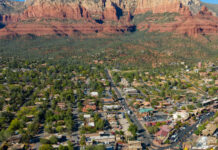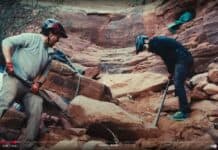The Red Rock Pass may no longer be needed in 85 percent of the area around Sedona.
The Bureau of Land Management’s Recreation Resource Advisory Council was set to decide on the issue Wednesday, Aug. 24, based on the U.S. Forest Service’s final proposal for updating the Red Rock Pass Program. The program requires recreationists to display a Red Rock Pass in their vehicles when parking on the Coconino National Forest.
According to Brady Smith, public information officer for the Coconino National Forest, the RAC was supportive of the proposal, but it must go to the regional forester in Albuquerque, N.M., before it can be written in as policy.
The proposal drastically reduces the pass’s coverage area from 160,000 acres of the Red Rock Ranger District of the Coconino National Forest — areas which included most of the land around Sedona and the Red Rock Secret Mountain, Munds Mountain and Sycamore Canyon wilderness areas — to roughly 12,000 acres.
The pass requirement was called into question with a judge’s ruling last year.
Much of the wider dispersed areas west and north of Sedona were lightly enforced, but some residents could still find tickets for $55 fines on their vehicles for not displaying passes. Citations were more common at busier locations.
The 12,000 acres where the pass must still be displayed are those with six key elements: designated developed parking; a permanent toilet facility; a permanent trash receptacle; an interpretive sign, exhibit or kiosk; picnic tables and security.
The final proposed areas include nine locations — seven individual sites and two areas.
The seven individual standard amenity recreation pass sites include:
- Palatki Heritage Site
- Honaki Heritage Site
- V-Bar-V Heritage Site
- Jim Thompson Trailhead, located off Jordan Road north of Uptown
- Boynton Canyon Trailhead, along Boynton Pass Road
- Doe and Bear Mountain Trailhead, along Boynton Pass Road just before the pavement ends
- Baldwin Trailhead, near the end of Verde Valley School Road
The two standard amenity recreation pass areas include:
- Oak Creek Canyon from Midgley Bridge just north of Sedona city limits to the Bootlegger Trailhead. This area includes Bootlegger, Banjo Bill, Halfway, Encinoso, Huckaby and Midgley Bridge trailheads.
- Red Rock Scenic Byway from southern Sedona city limits to the northern boundary of the Village of Oak Creek. This area includes Cathedral Rock, Little Horse, Courthouse Butte, Yavapai and the Bell Rock Vista and Pathway trailheads.
The areas were included because of heavy visitor use and local financial investment and sensitive water quality issues.
All seven individual sites have the six required amenities.
As a whole, the two areas have all six amenities although two trailheads lack picnic tables, and three lack both toilets and garbage receptacles.
There are 38 free sites where a pass is no longer required to reach a trailhead.
The program had its start with the 1996 Recreation Fee Demonstration Program, which sought to repair damage done by heavy usage by tourists and locals around Sedona.
The USFS began collecting fees in 2000. The fees funded the cleanup of 50 tons of trash and 60 abandoned vehicles, dismantling hundred of fire rings and transient camps, and closing miles of unauthorized roads and trails, according to the USFS.
On Dec. 8, 2004, Congress passed the Federal Lands Recreation Enhancement Act which specifically repealed the fee demonstration program but laid out guidelines for fee collection at sites determined as High-Impact Recreation Areas. The Coconino National Forest applied these HIRA rules to the whole of the 160,000 acres around Sedona.
In 2010, James Smith, a Sedona hiker, fought a citation the USFS issued him for not having a pass on his vehicle parked near the Vultee Arch Trailhead off Dry Creek Road northwest of Sedona. Similar fines had been challenged before in civil court, but Smith’s refusal to pay the $55 fine made the citation criminal and the U.S. Forest Service fined him $100.
U.S. Magistrate Judge Mark E. Aspey ruled in favor of Smith and wrote the HIRA was too broadly applied. The ruling effectively required the USFS to redefine specifically to which areas the pass was and wasn’t needed — only those with the six key elements qualified.
According to the fee program proposal, USFS fears the reduced areas where the pass is required may push visitors out to locations without amenities so they can avoid paying a fee.
In Sedona, this may bring more traffic to residential neighborhoods like Broken Arrow and Soldier Pass, which contain two of the most popular trailheads in Sedona.
Use may also increase at Fay, Aerie, Long Canyon and Turkey Creek trailheads, where the USFS may eventually add amenities to get them included in the fee areas.
Red Rock Ranger District staff did not return calls by press time.


















